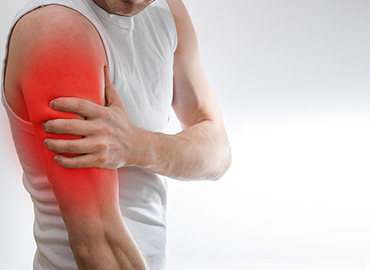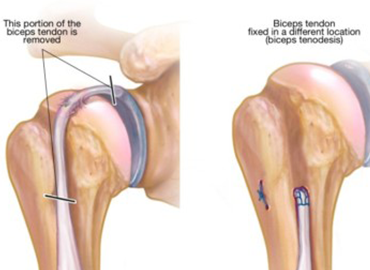Biceps Tendinitis
Home / Biceps Tendinitis
Biceps Tendinitis
Get AppointmentWhat is a Biceps Tendinitis?
Biceps tendinitis is an inflammation or irritation of the upper biceps tendon. Also called the long head of the biceps tendon, this solid cord-like structure connects the biceps muscle to the bone in the shoulder socket.
Pain in the front of the shoulder and weakness are common symptoms of biceps tendinitis. They can often be relieved with rest and medication. In severe cases, you may need surgery to repair the tendon.
Causes
Biceps tendonitis is typically caused in older age groups, other causes may be:
- Sudden injury to the upper biceps tendon, by lifting something too heavy or throwing a baseball, or playing tennis.
- Compression i.e., pushing, pinching or shearing, pulling.
- Weak rotator cuff and upper back muscles.
- Instability of shoulder joint muscles.
- Overuse and gradual wear and tear.
- Repetitive shoulder actions.
- Direct injury to the shoulder.
- Repeated overhead arm movements.
- History of shoulder dislocation or impingement.
- Trauma, like bumping or hitting the shoulder or upper arm against something.
- Diabetes.
- Diseases like gout and rheumatoid arthritis.
- Osteoarthritis.
Symptoms
Biceps tendon tears may happen quickly from a traumatic injury or develop over time from repetitive motions of the shoulder.
Symptoms include:
- A sudden, sharp pain in the upper arm, sometimes accompanied by a popping or snapping sound
- Cramping of the biceps during or after heavy use
- Pain or tenderness at the shoulder and elbow, or weakness in those areas
- The appearance of bruises from the middle of the bicep down toward the elbow
- Difficulty in rotating the arm to a palm upward (or downward) position
- A bulge in the upper arm, known as a “Popeye muscle”

Diagnosis
Diagnosis for inflammation of the long-head biceps tendon involves an examination of a patient’s bicep muscle and shoulder. The doctor will test for signs of tenderness and inflammation during the exam. Diagnostic tests such as X-rays and an MRI may also be ordered to identify other possible shoulder injuries.
Treatments
• Nonsurgical Treatments
Biceps tendinitis is typically first treated with simple methods. This type of nonsurgical treatment is usually effective in most patients.
Rest- The first step towards recovery is to avoid activities that cause pain.
Ice- Apply cold packs for 20 minutes at a time, several times a day, to keep swelling down. Do not apply ice directly to the skin.
Non-steroidal anti-inflammatory drugs (NSAIDs)- Anti-inflammatory drugs like ibuprofen, aspirin, and naproxen can reduce pain and swelling.
Steroid injections- Steroids such as cortisone are very effective anti-inflammatory medicines. Injecting steroids into the tendon can relieve pain.
Physical therapy. Specific stretching and strengthening exercises can help restore your range of motion and strengthen your shoulder.
Surgical Treatment
If your condition does not improve with non-surgical treatments, your doctor may offer surgery as an option. Surgery may also be an option if you have other associated shoulder problems.
Surgery for biceps tendinitis is usually performed arthroscopically. This allows your doctor to assess the condition of the bicep’s tendon as well as other structures in the shoulder.
During arthroscopy, your surgeon inserts a small camera, called an arthroscope, into your shoulder joint. The camera displays pictures on a television screen, and your surgeon uses these images to guide miniature surgical instruments.
Repair. Rarely, the biceps tendon can be repaired where it attaches to the shoulder socket (glenoid).
Biceps tenodesis. In some cases, the damaged section of the biceps is removed, and the surgeon attaches the remaining tendon to the upper arm bone (humerus). This procedure is called a biceps tenodesis. Removing the painful part of the biceps usually resolves symptoms and restores normal function.
Tenotomy. In some cases, the long head of the biceps tendon may be so damaged that it is not possible to repair or tenodese it. Your surgeon may simply elect to release the damaged biceps tendon from its attachment. This is called a biceps tenotomy. This option is the least invasive but may result in a Popeye bulge in the arm. Patients who have tenotomy usually do well and return to near-normal strength
Rehabilitation
After surgery, your doctor will prescribe a rehabilitation plan based on the procedures performed. You may wear a sling for a few weeks to protect the tendon repair.
Your doctor may restrict certain activities to allow the repaired tendon to heal. It is important to follow your doctor’s directions after surgery to avoid damage to your repaired biceps.
Your doctor will soon start you on therapeutic exercises. Flexibility exercises will improve the range of motion in your shoulder. Exercises to strengthen your shoulder will gradually be added to your rehabilitation plan

GET APPOINTMENT
Schedule Appointment : Your Path to Specialized Care
Get rid of your pain, stress, and enduring with our 24/7 dental services. It's a priority to relieve the pain in surgeon as much as possible. 90% of customers claim that they would come back & recommend us to others.
